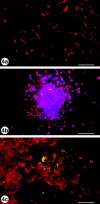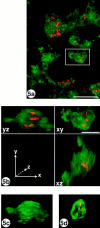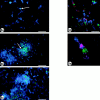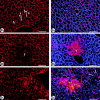Murine salmonellosis studied by confocal microscopy: Salmonella typhimurium resides intracellularly inside macrophages and exerts a cytotoxic effect on phagocytes in vivo
- PMID: 9254655
- PMCID: PMC2199036
- DOI: 10.1084/jem.186.4.569
Murine salmonellosis studied by confocal microscopy: Salmonella typhimurium resides intracellularly inside macrophages and exerts a cytotoxic effect on phagocytes in vivo
Abstract
Salmonella typhimurium is considered a facultative intracellular pathogen, but its intracellular location in vivo has not been demonstrated conclusively. Here we describe the development of a new method to study the course of the histopathological processes associated with murine salmonellosis using confocal laser scanning microscopy of immunostained sections of mouse liver. Confocal microscopy of 30-micron-thick sections was used to detect bacteria after injection of approximately 100 CFU of S. typhimurium SL1344 intravenously into BALB/c mice, allowing salmonellosis to be studied in the murine model using more realistic small infectious doses. The appearance of bacteria in the mouse liver coincided in time and location with the infiltration of neutrophils in inflammatory foci. At later stages of disease the bacteria colocalized with macrophages and resided intracellularly inside these macrophages. Bacteria were cytotoxic for phagocytic cells, and apoptotic nuclei were detected immunofluorescently, whether phagocytes harbored intracellular bacteria or not. These data argue that Salmonella resides intracellularly inside macrophages in the liver and triggers cell death of phagocytes, processes which are involved in disease. This method is also applicable to other virulence models to examine infections at a cellular and subcellular level in vivo.
Figures





References
-
- Bakken K, Vogelsang TM. The pathogenesis of Salmonella typhimuriuminfection in mice. Acta Pathol Microbiol Scand. 1950;27:41–50. - PubMed
-
- Miller CP, Bohnhoff M. Changes in the mouse's enteric microflora associated with enhanced susceptibility to Salmonellainfection following streptomycin treatment. J Infect Dis. 1963;113:59–66. - PubMed
-
- Finlay BB. Molecular and cellular mechanisms of Salmonellapathogenesis. Curr Top Microbiol Immunol. 1994;192:163–185. - PubMed
-
- Galan JE. Molecular and cellular bases of Salmonellaentry into non-phagocytic cells. Curr Top Microbiol Immunol. 1995;209:43–60. - PubMed
Publication types
MeSH terms
LinkOut - more resources
Full Text Sources
Molecular Biology Databases

